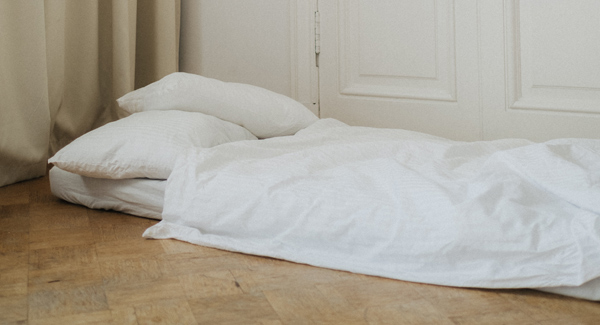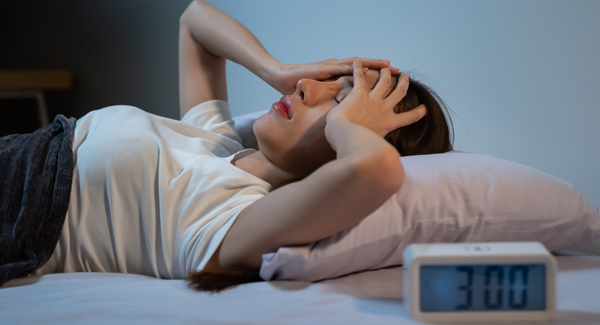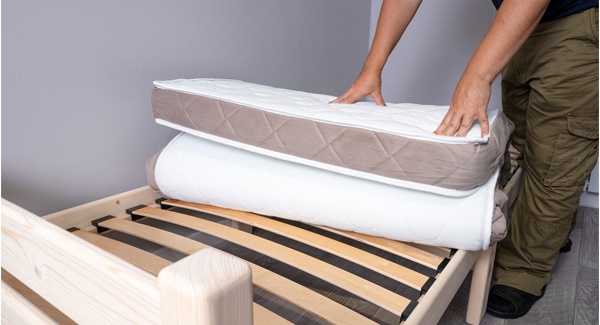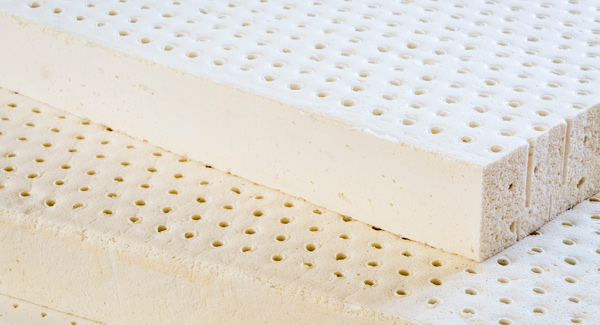Home » Mattress advice » Mattress On The Floor
Should you place a mattress on the floor?
Article navigation
- Published:
- Written by: Tony Brown
- Topic: Mattress advice
Most mattresses are designed to work with a bed base. However, there may be some circumstances where you consider placing your mattress directly on the floor. This could be because you have a bad back, are in the process of moving house, or are inspired by the Japanese way of life.
While it may seem a good idea initially, placing a mattress on the floor poses several risks and should be avoided where possible. Firstly, while a mattress provides comfort, the base provides the underlying support. The two are designed to work together. When a mattress is placed on the floor, you lose the support the bed base provides. You are also exposed to cold air and pests.
Another issue is the poor ventilation underneath the mattress when it is placed on the floor. Air needs to circulate freely underneath the mattress to prevent moisture from accumulating.
Placing your mattress on the floor could also invalidate its guarantee or warranty.
Disadvantages of using your mattress on the floor
Here’s a more detailed look at why you should not be using your mattress on the floor.
Poor ventilation
We lose around half a pint of body moisture each night during sleep, most of which ends up in the mattress. When you place your mattress directly on the floor, you restrict the ventilation underneath. Poor ventilation provides the perfect conditions for mould and mildew to grow.
A damp and humid environment will exacerbate the problem, especially if your mattress is susceptible to damp ground.
However, placing your mattress on a well-ventilated bed base will allow air to circulate freely underneath and prevent moisture from accumulating.
Exposure to bugs and pests
Sleeping on the floor exposes you to pests like spiders, bed bugs and even rodents. In ancient times, this was one of the reasons why beds were raised, to make it harder for pests to crawl over the bed.
Bed bugs can be particularly problematic and can easily gain access to your mattress if it is placed on the floor.
These tiny insects are active at night and can bite you on the areas of your skin often exposed during sleep, like your face and arms. A bite may cause some itching, soreness or irritation. Some people may even develop more severe symptoms like painful swelling.
As well as keeping your bedroom clean and clutter-free, ensuring your mattress is out of reach will help reduce the risk of an infestation.
Sleeping on the floor may provoke allergies
Dust mites are tiny insects barely visible to the human eye. They feed off dead skin cells and thrive in hot and humid environments.
Dust mites are prevalent in most homes and gather in bedding, mattresses, furniture, carpets and wherever dust gathers. They can trigger health problems and allergic reactions through their waste.
Putting your mattress on the floor means sleeping closer to where dust and dirt accumulate. This could provoke allergies which may cause sneezing, coughing, runny nose, itching or breathing issues. Regular cleaning while ensuring your bedroom is well-ventilated can help to alleviate the problem. One of the best ways to achieve this is to ensure your mattress is elevated and placed on a well-ventilated bed base.
Lack of support
Ideally, it helps to pair your mattress with its matching bed base. This can provide more support and help extend the life of the mattress. Because the mattress and base work together to support the body weight, this helps to take some of the strain from the mattress.
If the mattress is used with a sprung base, placing it on the floor will make the mattress feel firmer. However, a firm mattress is not necessarily better for a bad back. In the past, medical professionals often recommended sleeping on the floor or placing a board underneath the mattress for a bad back, but this advice has since changed. Correct support is mainly based on your body weight and build.
A firm mattress is typically recommended for someone that weighs more than 16 stone. Otherwise, a firm mattress may cause pressure points around the shoulders, hips and knees, depending on how you sleep.
Another misconception is that sleeping on the floor can promote better circulation. A firmer mattress may do the opposite and restrict blood circulation.
It may be difficult to get in and out of bed comfortably
Bed height should be proportionate with how tall you are. You should be able to sit comfortably on the edge of the mattress with both feet flat on the floor and your knees level with your hips.
If your mattress is on the floor, it can be difficult to comfortably get in and out of bed, especially for older adults and those with mobility issues. It may also put extra strain on your joints and muscles. Furthermore, you’ll put additional strain on the mattress each time you get in and out of bed.
Exposure to drafts
Sleeping on the floor exposes you to colder air. While this may sound appealing during warmer months, it can cause issues like headaches, skin irritations, muscle pain and even colds in the winter. The cold air may also make you feel uncomfortable in bed, resulting in more tossing and turning during sleep.
A higher bed will help you avoid cold drafts and bring you closer to the warmer air.
You may invalidate your manufacturer’s guarantee
Many manufacturers specify the type of base that is required for their mattresses. You could invalidate your guarantee if you use your mattress on the floor. Always check your manufacturer’s guarantee before using your mattress on the floor.
If you have to put your mattress on the floor
While putting your mattress directly on the floor should be avoided, there may be circumstances where this is unavoidable. For example, if you’re moving home or your existing bed base is damaged. If you find yourself in this situation, consider the following guidance:
- Repair any cracks in furniture, flooring and walls, as these are places where bed bugs often live during the day.
- Keep your bedroom clean and clutter-free. Clean the bedroom floor regularly.
- Always protect your mattress with a good quality breathable mattress protector. This will help protect your mattress from stains, spillages, moisture and even excreted waste from bed bugs and other pests.
- Place your mattress on top of a clean, breathable blanket, piece of plywood board or MDF to protect the mattress from dust, debris and damp ground. Drill some holes into the board to allow air circulation. Ensure the board’s surface is smooth to protect the mattress cover from damage.
- Open bedroom windows and doors to allow air to circulate.
- After taking a shower or bath, do not use the mattress until you have dried off.
- Consider using an air purifier or dehumidifier in the bedroom.
- Allow your bed to air in the morning before making it.
- Change your bedding regularly.
Final thoughts
Placing a mattress on the floor should be avoided where possible. However, if you’re considering it, it may help to speak to the retailer from which you purchased the mattress or contact the manufacturer directly beforehand.

About the author
Tony Brown is the founder and creator of The Bed Consultant. His career in the bed industry began in 2002. After graduating from university with a degree in Business Administration, Tony joined one of the largest independent furniture retailers in the UK as a bed consultant. Tony has helped thousands of customers find the perfect mattress.





